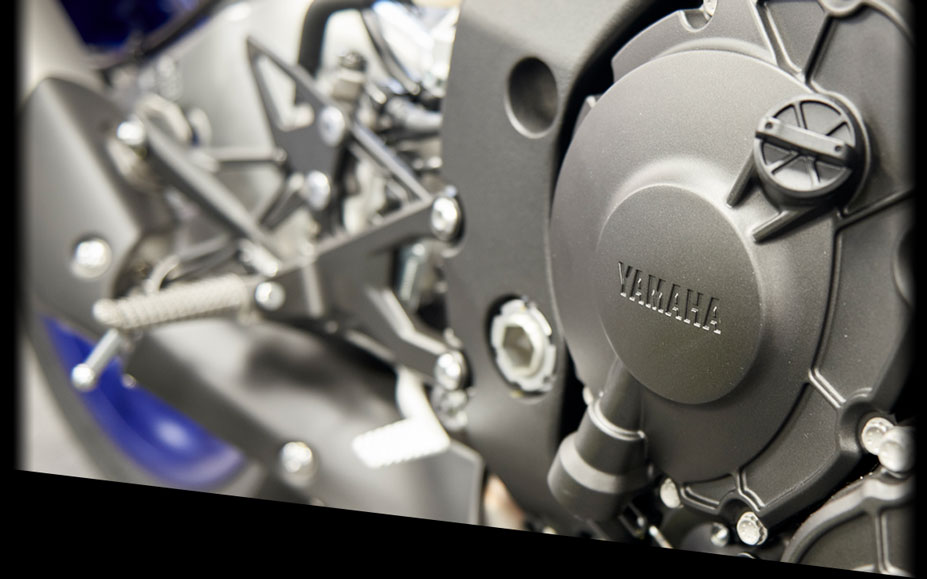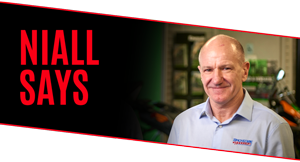
0333 0053 100

0333 0053 100


“There have been many special Yamahas in my life. The FS1E, R7, YZF750 and YZR500 are four amazing machines that I have a great fondness for, however the icon of icons for me is still the RD350 LC.
“I begged and borrowed just to put a deposit down the moment this bike was launched at Yamaha dealer Bill Fleming Motors in Glasgow, in June 1980. Three months later I took delivery of PUS 581W and my life changed forever. Initially, it was just the riding, cleaning and caressing that gave me a buzz but then I found racing.
"As a complete rookie, I immediately started winning club races, turned pro two years later, then became a full factory 500 Grand Prix rider three years after that. I must have had some talent, but without owning that 350 LC I would never have known.
“This bike was the first water cooled Yamaha for the road and it could out handle, out brake and outperform bikes double its capacity. It looked (and still does look) gorgeous, was a joy to ride and had that unique two-stroke whistle. Almost 40 years on it is still every bit as desirable. It is a very collectible model with prices now at 10 times the original purchase price. I own quite a few bikes but the white/blue Elsie in my garage is undoubtedly my favourite.”

“Yamaha are going through some tough times in MotoGP at the moment, but I don’t think it won’t be long before they pull themselves out of the doldrums. When I think about Yamaha, I think about handling. It’s always been their motto to build a bike that handles well so you can make up time in the corners. Over the years, this approach has become part of Yamaha’s DNA.
“On the road side of things, the R1 has been such an amazing model for them and continues to improve every time they bring a new model. I love the current R1M it’s such a lovely bike to ride.
“Everyone associates my career with Ducati but actually, the first bike I ever owned (well, it was my older brother Carl’s bike) was a Yamaha, the famous TY 80 trials bike. The funny thing is at the time it seemed so big and powerful but that said, I was only seven years old.
"My first ever race bike, when I started schoolboy motocross in 1983, was a YZ 80 when I was just 10. Then in 1990, I was back on a Yamaha on a TZR125 and this was my first season of road racing. I loved that bike but unfortunately, it didn’t like me, and I crashed out as I tried to adapt to the tarmac.
"After that rough start, five years later in 1995, I sat on the grid in the company of Doohan and Schwantz, aboard a 500 cc ROC Yamaha. It was quite a big step! What an amazing experience it was racing in the 500 Grand Prix on the powerful two-strokes. The only other time I rode a Yamaha was on an R1, right at the end of my career in 2010. Unfortunately, that didn’t go according to plan and resulted in a crash that ended my season and career.”
No matter what Yamaha motorbike you have, you’ll want complete peace of mind whilst you’re out riding. And at Mackenzie Hodgson, we’ve been providing riders with Yamaha motorbike insurance since we started.
We’ll find you the right level of Yamaha motorbike insurance for you depending on your personal circumstances and requirements.
The history of Yamaha can be traced back to 1887, when Mr Torakusa Yamaha built his first reed organ in Hamamatsu, Japan.
For almost 60 years the company continued to exclusively manufacture audio equipment and musical instruments, but following World War II, Yamaha was among the many Japanese companies to refocus its engineering capabilities.
Under the presidency of Genichi Kawakami the company moved into motorcycle manufacturing. In February 1955, Yamaha produced its first motorcycle, the 125cc YA-1, and the Yamaha Motor Company Limited was born.
Yamaha raced the bike, which was a copy of a German DKW and nicknamed the Red Dragonfly, at the famous Mt. Fuji Ascent race. Wearing the now famous tuning forks as a nod to their musical background, Yamaha proved its bike’s reliability by winning
the ultra-lightweight class.
Unlike many of their contemporaries, Yamaha quickly moved into overseas markets. In 1956, they took their YA-1 to race at the Catalina Grand Prix in the United States and quickly established themselves as a racing manufacturer. By 1961 Yamaha entered
the Grand Prix world championships, winning the 1963 Belgian 250cc Grand Prix with Fumio Ito riding. The following year saw Briton Phil Read win the world 250cc title on a Yamaha RD56. By 1973 Yamaha had entered the top, 500cc, class and soon
attracted the legendary Giacomo Agostini to their ranks. The Italian superstar won the title in 1975.
This period also saw Yamaha introduce some of its most iconic road bikes. Launched at the tail end of 1969, the Yamaha XS-1 was the company’s first big bike. Powered by a 650cc parallel-twin, four-stroke, engine the design was reminiscent of
the popular British bikes of the day, albeit more modern in its manufacture and technology.
The XS established Yamaha as one of the major players in the motorcycle industry, but it was with two-stroke machines with which the company attracted a legion of new fans.
For many riders, the RD350 was the definitive sports bike of the 1970s. With its lightweight two-stroke parallel twin engine, the RD was the ultimate hooligan machine. By 1980 the RD350 had gained water cooling and became the RD350LC. Promoted by
the televised Pro-Am race series, from which future superstars Alan Carter and Niall Mackenzie would emerge, the LC (commonly nicknamed Elsie) remains a Yamaha icon. This era also saw the introduction of the FS-1E (aka Fizzy) moped, of which around
200,000 were sold in the UK alone.
Yamaha’s reputation as the kings of the two stroke was cemented by its racing exploits. In 1978 a brash American by the name of Kenny Roberts came to Europe and wrestled the 500cc world title crown from Barry Sheene. Having grown up racing an
XS650 on oval dirt tracks, King Kenny brought a new style of riding to the Continental Circus, as well as new levels of professionalism. He won back to back titles for Yamaha between 1978 and 1980, before setting up Team Roberts and guiding future
American Yamaha champions Eddie Lawson and Wayne Rainey to world titles.
Roberts also brought with him the famous black and yellow speed block livery. Officially the colours of Yamaha’s US subsidiary, the design remains an icon and is regularly applied to the company’s road bikes today.
As the world moved away from two-strokes, so Yamaha went with the times. The FZ750 of 1985 was an inline four-cylinder sports bike that introduced the concept of the five-valve cylinder head, a Yamaha trademark that was the signature of the company’s
sports bikes for almost 20 years. The FZ750 also featured a cylinder block that was inclined by 45-degrees, known as the Genesis concept. Yamaha also pioneered the modern style ‘Deltabox’ frame in Grand Prix racing, transferring the
technology to the mass market with 1987’s FZR1000.
Indeed a major part of Yamaha’s attraction over the years has been the way in which the company has been able to transfer technology from the racetrack to the showroom. In 1998 the company introduced its iconic R-series and the YZF-R1. With 150bhp in a short 190kg package, the R1 rewrote the rulebook for sports bikes and created an all-new 1000cc superbike class.
The R1 remains Yamaha’s flagship today, being refined year-upon-year with the latest technology filtering down from
the MotoGP programme. The R1’s little brother, the YZF-R6, has also been a cornerstone of the range for two decades and remains the bike to beat in supersport racing around the world.
After a stuttering start in the MotoGP era of racing, Yamaha has become one of the major players again in the world championships. The company pulled a masterstroke by luring Valentino Rossi to ride their previously uncompetitive YZR-M1 in 2004. The
Italian rewarded them by winning first time out and taking four titles between 2004 and 2009. Spaniard Jorge Lorenzo added three further championship wins between 2010 and 2015.
Yamaha has also been a major player in the off-road scene with the YZ series of motocross bikes, as well as in the Dakar rally.
After a few years in the doldrums, Yamaha is back at the top of its game and making everything from entry level scooters to the latest YZF-R1M superbike.
A big part of the company’s resurgence in recent years has been the MT range of aggressively styled nakeds that combine sharp looks with strong performance and keen prices. The two-cylinder MT-07 and three-cylinder MT-09 remain true to the layouts
of 1970s XS models but are thoroughly modern and tremendous fun to ride. Yamaha’s scooters remain hugely popular on the continent, especially the range topping TMAX, while the sporty YZF-R125 remains one of Britain’s most popular learner
bikes.
It’s been a long journey from making pianos to winning MotoGP titles but Yamaha continues to be one of the most innovative manufacturers with a loyal following and one of the most comprehensive range of models on the market today.